VP40, the matrix protein of Marburg virus, is associated with membranes of the late endosomal compartment
- PMID: 11799178
- PMCID: PMC135914
- DOI: 10.1128/jvi.76.4.1825-1838.2002
VP40, the matrix protein of Marburg virus, is associated with membranes of the late endosomal compartment
Abstract
Localization of VP40 in Marburg virus (MBGV)-infected cells was studied by using immunofluorescence and immunoelectron microscopic analysis. VP40 was detected in association with nucleocapsid structures, present in viral inclusions and at sites of virus budding. Additionally, VP40 was identified in the foci of virus-induced membrane proliferation and in intracellular membrane clusters which had the appearance of multivesicular bodies (MVBs). VP40-containing MVBs were free of nucleocapsids. When analyzed by immunogold labeling, the concentration of VP40 in MVBs was six times higher than in nucleocapsid structures. Biochemical studies showed that recombinant VP40 represented a peripheral membrane protein that was stably associated with membranes by hydrophobic interaction. Recombinant VP40 was also found in association with membranes of MVBs and in filopodia- or lamellipodia-like protrusions at the cell surface. Antibodies against marker proteins of various cellular compartments showed that VP40-positive membranes contained Lamp-1 and the transferrin receptor, confirming that they belong to the late endosomal compartment. VP40-positive membranes were also associated with actin. Western blot analysis of purified MBGV structural proteins demonstrated trace amounts of actin, Lamp-1, and Rab11 (markers of recycling endosomes), while markers for other cellular compartments were absent. Our data indicate that MBGV VP40 was able to interact with membranes of late endosomes in the course of viral infection. This capability was independent of other MBGV proteins.
Figures
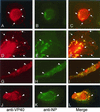
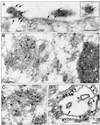

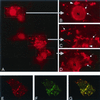

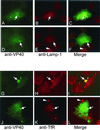
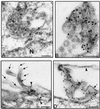
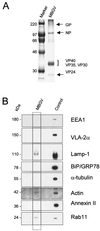

Similar articles
-
The matrix protein of Marburg virus is transported to the plasma membrane along cellular membranes: exploiting the retrograde late endosomal pathway.J Virol. 2004 Mar;78(5):2382-93. doi: 10.1128/jvi.78.5.2382-2393.2004. J Virol. 2004. PMID: 14963134 Free PMC article.
-
Marburg virus inclusions: A virus-induced microcompartment and interface to multivesicular bodies and the late endosomal compartment.Eur J Cell Biol. 2015 Jul-Sep;94(7-9):323-31. doi: 10.1016/j.ejcb.2015.05.006. Epub 2015 May 30. Eur J Cell Biol. 2015. PMID: 26070789
-
Multivesicular bodies as a platform for formation of the Marburg virus envelope.J Virol. 2004 Nov;78(22):12277-87. doi: 10.1128/JVI.78.22.12277-12287.2004. J Virol. 2004. PMID: 15507615 Free PMC article.
-
Host and Viral Proteins Modulating Ebola and Marburg Virus Egress.Viruses. 2019 Jan 3;11(1):25. doi: 10.3390/v11010025. Viruses. 2019. PMID: 30609802 Free PMC article. Review.
-
The Role of Exosomal VP40 in Ebola Virus Disease.DNA Cell Biol. 2017 Apr;36(4):243-248. doi: 10.1089/dna.2017.3639. Epub 2017 Feb 8. DNA Cell Biol. 2017. PMID: 28177658 Free PMC article. Review.
Cited by
-
Lipid-specific oligomerization of the Marburg virus matrix protein VP40 is regulated by two distinct interfaces for virion assembly.J Biol Chem. 2021 Jan-Jun;296:100796. doi: 10.1016/j.jbc.2021.100796. Epub 2021 May 18. J Biol Chem. 2021. PMID: 34019871 Free PMC article.
-
Angiomotin Counteracts the Negative Regulatory Effect of Host WWOX on Viral PPxY-Mediated Egress.J Virol. 2021 Mar 25;95(8):e00121-21. doi: 10.1128/JVI.00121-21. Epub 2021 Feb 3. J Virol. 2021. PMID: 33536174 Free PMC article.
-
Electron tomography reveals the steps in filovirus budding.PLoS Pathog. 2010 Apr 29;6(4):e1000875. doi: 10.1371/journal.ppat.1000875. PLoS Pathog. 2010. PMID: 20442788 Free PMC article.
-
Tsg101 is recruited by a late domain of the nucleocapsid protein to support budding of Marburg virus-like particles.J Virol. 2010 Aug;84(15):7847-56. doi: 10.1128/JVI.00476-10. Epub 2010 May 26. J Virol. 2010. PMID: 20504928 Free PMC article.
-
Advances in virus-like particle vaccines for filoviruses.J Infect Dis. 2011 Nov;204 Suppl 3(Suppl 3):S1053-9. doi: 10.1093/infdis/jir346. J Infect Dis. 2011. PMID: 21987741 Free PMC article. Review.
References
-
- Becker, S., H.-D. Klenk, and E. Mühlberger. 1996. Intracellular transport and processing of the Marburg virus surface protein in vertebrate and insect cells. Virology 225:145-155. - PubMed
-
- Becker, S., C. Rinne, U. Hofsäss, H.-D. Klenk, and E. Mühlberger. 1998. Interactions of Marburg virus nucleocapsid proteins. Virology 249:406-417. - PubMed
-
- Bordier, C. 1981. Phase separation of integral membrane proteins in Triton X-114 solution. J. Biol. Chem. 256:1604-1607. - PubMed
-
- Bretscher, M. S., and C. Aguado-Velasco. 1998. Membrane traffic during cell locomotion. Curr. Opin. Cell Biol. 10:537-541. - PubMed
Publication types
MeSH terms
Substances
LinkOut - more resources
Full Text Sources
Other Literature Sources
Miscellaneous

